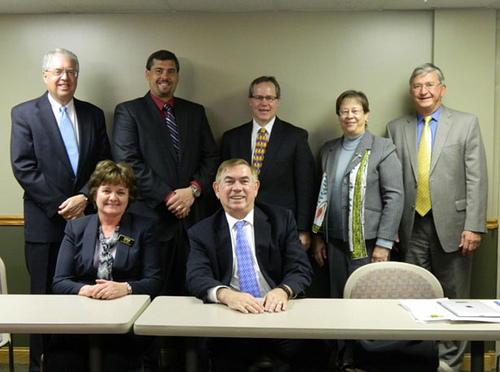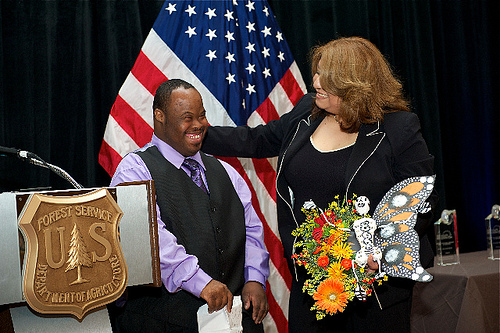
Front row: Mary Honke, Vice President for Institutional Advancement and Dr. Greg Smith, President of Central Community College. Back row from left to right are: Dr. Jack Huck, President of Southeast Community College; Ryan Purdy, Interim President of Mid-Plains Community College; Dr. Todd Holcomb, President of Western Community College; State Director Maxine Moul; and Dennis Baack, Executive Director of the Nebraska Community College Association.
Local colleges and USDA Rural Development are combining resources to improve the availability of higher education in rural areas. This increased emphasis on continuing education will bring a stronger work force to Nebraska. Read more »
About midway through USDA’s 150-year history, federal officials decided that economic research and analysis could be a valuable, objective tool in helping farmers – and policymakers – grapple with farm price and income issues. In 1922, the Bureau of Agricultural Economics (BAE) – predecessor agency of USDA’s Economic Research Service (ERS) – came into existence. The Bureau began regularly producing agricultural market outlook reports (still an ERS staple), and – not surprisingly – its early work included analysis of agricultural policy impacts during the Great Depression.

Employees of the Bureau of Agricultural Economics (circa 1930), predecessor agency of the Economic Research Service.
Although the BAE’s functions were dispersed throughout the Department in the 1950s, they were assembled again into a single agency, the Economic Research Service, in 1961. I’ll touch on just a few highlights of ERS activities that illustrate the value of our agency’s work over the past century. Read more »
Remember the devastating floods in Vermont – the worst in a century – that made national headlines late last August? Hurricane Irene pounded Vermont and the Green Mountain National Forest and New Hampshire and the White Mountain National Forest with up to 12 inches of rain in less than a day. Many communities were left reeling from the massive flood damage for weeks and months in post-storm recovery efforts.
More than 500 road miles and 200 bridges and culverts were destroyed or damaged. Communities were left stranded by the flood’s devastation of the transportation infrastructure. Millions of dollars of property damage occurred. Residents also suffered increased costs related to emergency service access, commuting time and lost tourism revenue. Aquatic life was also harmed when heavy machinery cleared “debris” and reshaped rivers. Read more »
Since 2009, USDA Rural Development has helped 512 rural small businesses and farmers install renewable energy systems or make energy efficiency improvements through the Rural Energy for America Program (REAP).

Senator Al Franken and Minn. Rural Development State Director Colleen Landkamer participate in a roundtable meeting on the USDA Rural Energy For America Program.
On Tuesday, April 10, about 40 of those farmers and small business owners gathered in Mankato, Minn., to discuss the REAP program during a roundtable featuring Senator Al Franken and USDA Rural Development State Director Colleen Landkamer. Read more »
Migratory species play unique ecological roles because of their intrinsic beauty and significance in culture and identity. Despite this, bats, birds, butterflies and dragonflies face a multitude of threats both in the US and in Latin America and the Caribbean where they migrate during the winter. If these habitats are not protected, the tremendous US domestic investment in conserving these species is wasted.

Receiving the award for “Communities in Conservation” are Luisa Lopez, Counselor at El Valor and Vincent Jordan, participant in El Valor's Adults with Different Abilities Program. They are holding one of the products of this program—a monarch butterfly made for Día de los Muertos, or Day of the Dead.
An award ceremony for conservation of birds, bats and butterflies was recently held in Atlanta. The 2012 Wings Across the Americas event paid special tribute to partnerships that contribute to conservation efforts. Read more »
Does your citrus tree have spotted leaves or fruit with brown raised spots or small lopsided fruit? Good news, USDA released a free Save Our Citrus iPhone app that makes it easy to identify and report the four leading citrus diseases: citrus greening, citrus canker, citrus black spot and sweet orange scab.
In just a few steps, the Save Our Citrus app, available in English and Spanish, allows you to report the symptoms, upload a photo and receive an individual response back from citrus experts. Read more »
Tags: APHIS, Blueprint for Stronger Service, citrus black spot, citrus canker, citrus greening, citrus health, iPhone app, Plant Protection and Quarantine, Save Our Citrus, sweet orange scab
 Environment, Technology and Broadband
Environment, Technology and Broadband




